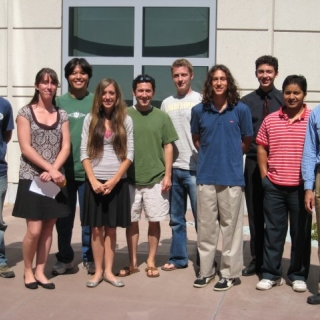A total of 4 undergraduates from the universities below and 4 local high school students participated in the summer internship in 2008.
-
California State University, San Bernadino
-
University of California, San Diego
2008 Research Report
Projects
Querying Significant Patterns in Image Database
Mentor
Ambuj Singh (faculty advisor), Vishwakarma Singh
Student Interns
Deepak BaliCalifornia State University, San Bernadino
Abstract
Images are becoming an important source in many scientific and commercial domains. Analysing such images often requires the retrieval of the best subregions matching a given query. A content based similarity search of images finds the closest images to a given query image based on the distances between specified feature vectors of the query image and of the images in the collection searched. This is especially useful for biological images when used with the feature extraction methods developed by researchers at UCSB Algorithms lab. The Quip Algorithm approaches the problem in a dynamic way and demonstrates efficient and fast searches.
A Benchmarking Website
Mentor
B.S. Manjunath (faculty advisor), Boguslaw Obara
Student Interns
Matthew StraderCalifornia State University, San Bernadino
Abstract
The importance of evaluating image analysis algorithms is the ability to compare the effectiveness of algorithms that attempt to solve the same class of problem. With a comprehensive score that incorporates all of the metrics important to a particular class of problem, one algorithm may be deemed more effective than another. Competition among algorithms facilitates the sharing of ideas and the progression towards better algorithms. A benchmarking website makes image datasets available for algorithm designers to test their image analysis algorithms and receive feedback on how their algorithms compare to others.
Evaluating the Performance of 3D Nuclei Detection Algorithms
Mentor
B.S. Manjunath (faculty advisor), Elisa Drelie Gelasca
Student Interns
Aram AcemyanCalifornia State University, San Bernadino
Abstract
In the growing field of biological computing it has become important to create standard methods of evaluating segmentation and detection algorithms. With many researchers coming up with there own methods of segmentation it is important to have a way to score each algorithm and determine who’s algorithms are performing best. These evaluation algorithms are important for creating benchmarks for Evaluation and Analysis. The 3D Nuclei Detection Evaluation will be used to rate the results of 3D Nuclei Detection algorithms.
Ganglion Cell Ground Truths
Mentor
Steven Fisher (faculty advisor), Chris Banna
Student Interns
Jonathan OkerblomUniversity of California, San Diego
Abstract
Retinal ganglion cells carry the pre-processed impulses of the retina to the brain where vision is finally perceived. Our project aims to identify changes in retinal ganglion cell morphology induced by an experimental mouse model of retinal detachment. Historically, immunohistochemical (IHC) techniques have labeled growth associated protein upregulation in ganglion cells, but have had minimal success identifying morphological changes, especially in mice. This project aims to take a much closer look at ganglion cells in the mouse model to determine their true morphological nature after detachment.

